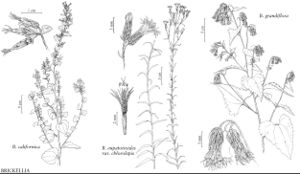Brickellia grandiflora
Trans. Amer. Philos. Soc., n. s. 7: 287. 1840.
Perennials, 30–95 cm (taproots thickened). Stems branched, puberulent. Leaves opposite or alternate; petioles 10–70 mm; blades 3-nerved from bases, deltate-ovate, lanceovate, or subcordate, 15–120 × 20–70 mm, bases acute, truncate, or subcordate, margins crenate, dentate, or serrate, apices attenuate, faces puberulent and glanddotted. Heads (nodding in flower and fruit) in loose, corymbiform or paniculiform arrays. Peduncles 4–30 mm, pubescent. Involucres cylindric or obconic, 7–12 mm. Phyllaries 30–40 in 5–7 series, greenish, 4–5-striate, unequal, margins scarious; outer lanceovate to lanceolate (pubescent, margins ciliate, apices long-acuminate), inner lanceolate to lance-linear (glabrous, apices acute to acuminate). Florets mostly 20–40 (–70); corollas pale yellow-green, 6.5–7.5 mm. Cypselae 4–5 mm, hispidulous to hirtellous; pappi of 20–30 white, barbellate bristles. 2n = 18.
Phenology: Flowering Jul–Oct.
Habitat: Rocky hillsides, shaded forests, dry slopes, canyons
Elevation: 1200–3000 m
Distribution

Ariz., Ark., Calif., Colo., Idaho, Kans., Mo., Mont., Nebr., Nev., N.Mex., Oreg., Tex., Utah, Wash., Wyo.
Discussion
Selected References
None.
Lower Taxa
"fine" is not a number.
